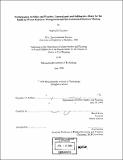| dc.contributor.advisor | David Laws. | en_US |
| dc.contributor.author | Tavanlar, Katrina D. (Katrina Domaoal), 1973- | en_US |
| dc.contributor.other | Massachusetts Institute of Technology. Dept. of Urban Studies and Planning. | en_US |
| dc.date.accessioned | 2012-04-26T18:40:03Z | |
| dc.date.available | 2012-04-26T18:40:03Z | |
| dc.date.copyright | 1999 | en_US |
| dc.date.issued | 1999 | en_US |
| dc.identifier.uri | http://hdl.handle.net/1721.1/70322 | |
| dc.description | Thesis (M.C.P.)--Massachusetts Institute of Technology, Dept. of Urban Studies and Planning, 1999. | en_US |
| dc.description | Includes bibliographical references (leaves 73-75). | en_US |
| dc.description.abstract | Public participation plays an important role in environmental decision making and policy formulation. Federal and state agencies charged with the responsibilities of determining laws to manage environmental problems are mandated to include participation in their regulatory rulemaking. In most cases, public participation takes place in conventional forums such as public hearings, meetings, and workshops. These forums have limited capacity for true deliberation or discussion between the public and the government agency. In this conventional view, the competency of the citizen in the participation process should be questioned. Because the public may be ill informed or have a limited knowledge of technical and political information, decision making and policy making should be left to experts. Despite the prevalence of these conventional models, alternative models to standard practice have arisen and are currently utilized. These models incorporate greater deliberation and take the form of citizen advisory committees and mediated consensus building processes. Alternative models of participation acknowledge that the citizenry, because of their unique knowledge of local conditions and intellectual capacity to generate and formulate ideas and solutions, are essential to decision making and policy formulation. The CALFED Bay-Delta Program, created specifically to address the pressing environmental and water management problems in the San Francisco/San Joaquin Bay-Delta, espoused the virtues of new and alternative approaches to dealing with decades-old controversies and conflicting interests. In this thesis, I have compared CALFED's policies and strategies for public participation with their actual practice. In seeking to reconcile policy with practice, I acknowledge that CALFED has attempted to engage the public. But despite the acknowledgement and emphasis on alternative approaches that seek to resolve conflict, CALFED's strategies, in practice, adhere to conventional approaches. Deliberation in both public outreach forums and citizen advisory committees has been limited. When deliberation has been realized in the CALFED process, it has been in small, sporadic events that incorporate highly structured and facilitated processes. | en_US |
| dc.description.statementofresponsibility | by Katrina D. Tavanlar. | en_US |
| dc.format.extent | 75 leaves | en_US |
| dc.language.iso | eng | en_US |
| dc.publisher | Massachusetts Institute of Technology | en_US |
| dc.rights | M.I.T. theses are protected by
copyright. They may be viewed from this source for any purpose, but
reproduction or distribution in any format is prohibited without written
permission. See provided URL for inquiries about permission. | en_US |
| dc.rights.uri | http://dspace.mit.edu/handle/1721.1/7582 | en_US |
| dc.subject | Urban Studies and Planning. | en_US |
| dc.title | Participation in policy and practice : conventional and deliberative roles for the public in water resources management and environmental decision-making | en_US |
| dc.type | Thesis | en_US |
| dc.description.degree | M.C.P. | en_US |
| dc.contributor.department | Massachusetts Institute of Technology. Department of Urban Studies and Planning | |
| dc.identifier.oclc | 44053204 | en_US |
